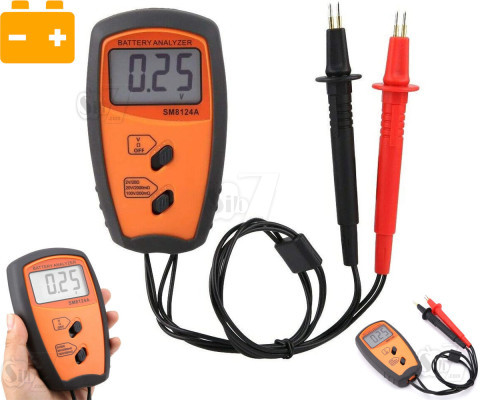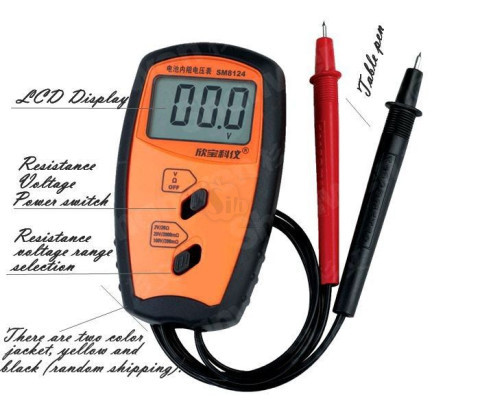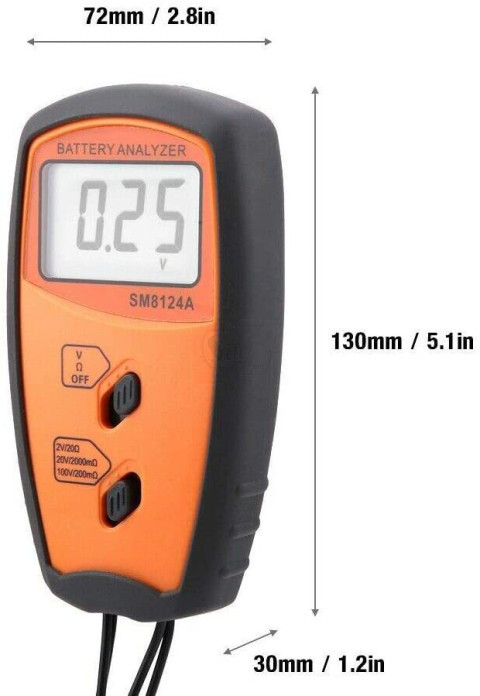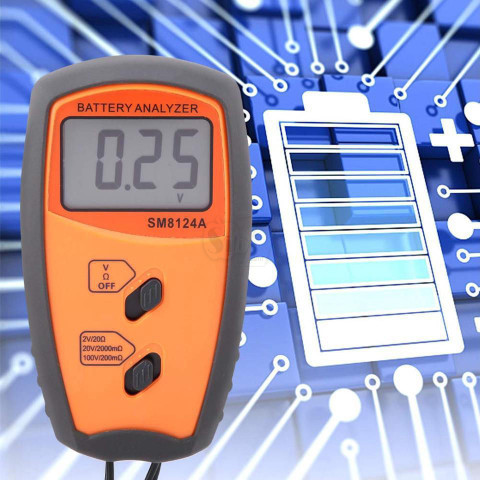SM8124 Battery Analyzer & Impedance Meter and Voltmeter of internal battery resistance is mainly used to measure battery terminal voltage and internal resistance.
The internal resistance is measured with the international standard AC signal (1000Hz±10%) by means of four wire method to ensure the impact of the test probe of the contact resistance of the instrument, the wire and battery output terminal on the measured value and the battery voltage can also be measured at the same time.
It is applicable for measurement of internal resistances of Lithium-ion, nickel-hydroxide, lithium-manganese cells or assembled battery.
Notice:
The instrument should not exceed the test voltage 200V, otherwise it will cause permanent damage to the instrument
red lead should be connected to high voltage end of the battery (positive side), black lead should be connected to the battery's low voltage end of the measured (negative side);
The instrument is a micro-power smart meters, remove the batteries when not used
do not test the AC as to avoid damage to the instrument
Specification:
Model: SM8124A
Internal resistance Measurement Range: 0.2ohm, 2ohm, 20ohm
Internal Resistance Resolution: 0.2ohm(0.0001ohm), 2ohm(0.001ohm), 20ohm(0.01ohm
Voltage Measurement Range: 0~2V,2V~20V,20~200V
Voltage resolution:(0~2V)1mV ,(2V~20V)10mV, (20V~200V)100mV
Working Environment temperature: -10~+40C
Power: One 9V Battery (not include)
Display: LCD.
Low Voltage prompt
Size:130×72×30mm
INSTRUCTIONS:
A: Battery internal resistance measurement
- Open the battery door into the instrument a 9V battery, close the battery door.
- the location of the power switch to "Ω" gear, the display shows this case "1" range selection "200V / 200mΩ" file, will lead to the battery positive electrode, a negative electrode, such as readings show "1" Select "20V / 2000mΩ" or "2v / 20Ω" file.
- When the over-range meter shows "1."
- After completion of the measurement set the switch to the "OFF" file off the power.
B: Battery voltage measurement
- Open the battery door into the instrument a 9V battery, close the battery door.
- The power switch position "V" file, showing a "0" on the display case, the rated voltage of the battery measured by reference to select the appropriate gear (Note: The selected gear should be greater than the rated voltage to avoid damaging instruments), will lead to the battery positive electrode, a negative electrode.
- The instrument does not display the voltage polarity, only voltage absolute value.
- When the over-range meter shows "1." Please immediately switch to a larger gear, in case I do not know how much voltage is about, set the switch to 200V / 200mΩ / stalls, measured value less than 20V, can be appropriated 20V / 2000mΩ files, inadequate measurement When 2V, can dial to 2V / 20Ω file. Voltage tests, state-of-range of the instrument is dangerous, please be avoided.
- After completion of the measurement set the switch to the "OFF" file off the power.
Note
This instrument is a high-precision measuring instruments in use should note the following:
- The instrument test terminal voltage should not exceed 200V, otherwise it will cause permanent damage to the instrument;
- When measuring the red lead should be connected to the high voltage side test battery (positive side), black lead should be connected to the low voltage side of the battery under test (negative side);
- When measuring the battery internal resistance leads to directly to the battery's positive and negative output terminal, can not have wire connections transition (because the internal resistance of the connecting wires have also been included in the internal resistance of the battery) to ensure accurate measurement results.
- The instrument is a micro-power smart meters, in a long time when not in use to remove the battery;
Do not touch the AC signal leads, so as not to damage the instrument.
No reviews found










